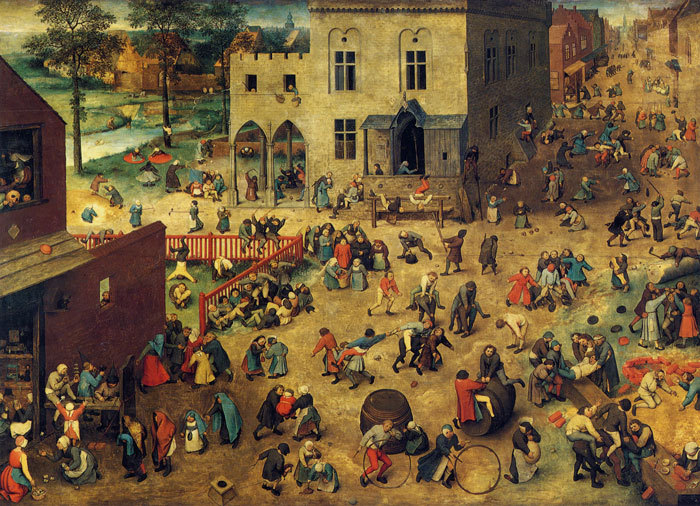Pieter Bruegel the Elder’s "Children's Games"

Annotation
Flemish painter, Pieter Bruegel the Elder, painted "Children's Games" in 1560. While many of his other paintings also portray peasant folk culture, this summer townscape that is devoid of adults is rich in detail about Medieval children—especially at play. The painting provides a window into amusements and recreations in the past in its detailed depiction of some 200 children engaged in nearly 80 different games and play activities. Many (although not all) of the outdoor activities included in this visual compendium of 16th-century children's play will be recognizably familiar.
Physically energetic and imaginatively engaged girls and boys are everywhere in Bruegel's busy painting. Some are using their bodies, others are playing with children and/or with toys (e.g., windmill; hoops). Here are some examples. Three boys mounted on a red fence are pretending to race horses. A few are playing leapfrog and others playing "horsey" and "tug of war." Another is straddling a hobbyhorse. Two girls are playing a medieval form of jacks (knucklebones) but with a bone instead of a ball. A group of children playing dress-up are staging a wedding. A small group of boys are spinning tops (a popular toy). A girl is playing musical instruments, another with a doll. A few boys are balancing on barrels. Some children are engaged in solitary play (e.g., blowing bubbles; dollmaking). While some are playing gently, there are rough bullies here as well.
In addition to this painting and additional ones by Bruegel the Elder there are other useful sources of information about children's play in medieval Europe. Illuminated manuscripts from the Netherlands include noteworthy depictions of children at play. Other kinds of evidence can be drawn from poetry, such as, The Pilgrim of the Life of Man, a French poem translated in 1426 by the English poet John Lydgate. It includes an energetic girl, named Youth, with a passion for play. She enumerates 25 different activities and games. Archeologists also have located toys and other objects for material culture analysis. A highly useful secondary source is Nicholas Orme's Medieval Children (Yale University Press, 2001). A comprehensive chapter on "play" is also lavishly illustrated with art and artifacts.
Credits
"File:Children.jpg", Wikimedia Comomons, http://commons.wikimedia.org/wiki/File:Children.jpg (accessed October 23, 2009). Annotated by Miriam Forman-Brunell.